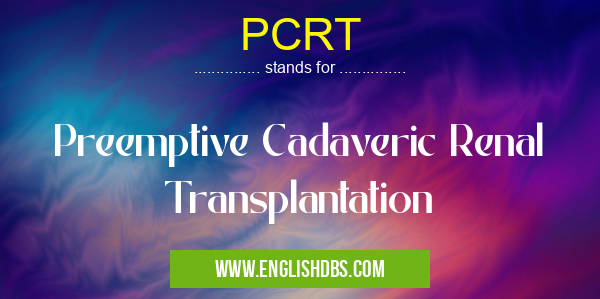What does PCRT mean in TRANSPLANTATION
Preemptive Cadaveric Renal Transplantation (PCRT) is a type of kidney transplant that is performed before a patient with end-stage kidney disease starts dialysis. In PCRT, a patient receives a kidney from a deceased donor (cadaver donor) while they still have some remaining kidney function.

PCRT meaning in Transplantation in Medical
PCRT mostly used in an acronym Transplantation in Category Medical that means Preemptive Cadaveric Renal Transplantation
Shorthand: PCRT,
Full Form: Preemptive Cadaveric Renal Transplantation
For more information of "Preemptive Cadaveric Renal Transplantation", see the section below.
- PCRT stands for Preemptive Cadaveric Renal Transplantation, a medical procedure that involves transplanting a kidney from a deceased donor to a patient with end-stage renal disease (ESRD) before the patient requires dialysis.
Preemptive Cadaveric Renal Transplantation (PCRT)
- PCRT offers several advantages over dialysis-dependent transplantation. It eliminates the need for dialysis, which can be physically and emotionally taxing for patients.
- It helps to maintain better overall health and quality of life.
- It provides a longer graft survival time compared to transplants performed after dialysis initiation.
Patient Selection
- Patients with ESRD who are stable and have a good life expectancy are typically considered for PCRT.
- Factors such as the patient's age, underlying medical conditions, and social support system are taken into account.
Procedure
- PCRT is performed similarly to other kidney transplants.
- The patient receives immunosuppressive medications to prevent organ rejection.
- After surgery, the patient is closely monitored for any complications.
Benefits
- Eliminates the need for dialysis: PCRT allows patients to avoid the physical and emotional burdens associated with dialysis.
- Better health outcomes: PCRT helps to preserve kidney function and overall health, reducing the risk of complications and improving quality of life.
- Longer graft survival: Transplants performed preemptively have a longer survival time compared to those performed after dialysis initiation.
Essential Questions and Answers on Preemptive Cadaveric Renal Transplantation in "MEDICAL»TRANSPLANTATION"
What is Preemptive Cadaveric Renal Transplantation (PCRT)?
Who is a candidate for PCRT?
Patients with end-stage kidney disease who are expected to start dialysis within a year are typically considered candidates for PCRT. Other factors that may be considered include the patient's overall health, age, and willingness to undergo surgery.
What are the benefits of PCRT?
PCRT offers several benefits over starting dialysis first. These benefits include:
- Reduced risk of cardiovascular disease and other complications associated with dialysis
- Improved quality of life
- Potential for a longer-lasting kidney transplant
- Lower overall healthcare costs
What are the risks of PCRT?
As with any surgery, PCRT carries some risks. These risks include:
- Infection
- Bleeding
- Rejection of the transplanted kidney
- Death
How successful is PCRT?
The success rate of PCRT is generally high, with most patients experiencing long-term kidney function. The overall survival rate for patients who receive a kidney transplant within a year of starting dialysis is also significantly higher than for those who start dialysis first.
Final Words:
- PCRT is a valuable treatment option for patients with ESRD.
- It offers several advantages over dialysis-dependent transplantation, including improved health outcomes, reduced complications, and better quality of life.
- Careful patient selection and appropriate medical management are crucial for successful PCRT outcomes.
